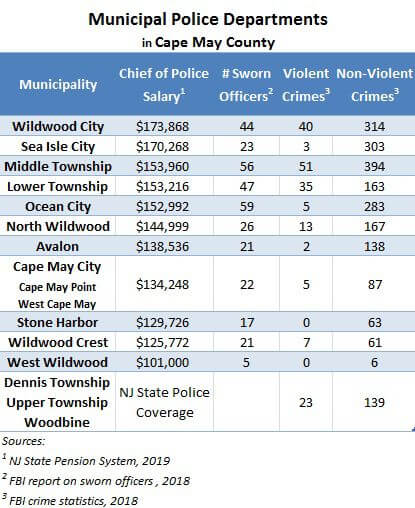The structure of law enforcement in New Jersey is heavily influenced by the state’s tradition of home rule. Federal Bureau of Investigation (FBI) statistics for 2018 cite 576 law enforcement agencies in the state, with over 30,000 sworn officers.
Two-thirds of New Jersey law officers reside in municipal police departments, of which the FBI lists 464 in New Jersey, with 20,598 sworn officers and 3,835 civilian employees. This list omits municipal areas patrolled by New Jersey State Police (NJSP).
Cape May County has 11 police departments, one of which, Cape May City Police, serves three municipal entities – Cape May, West Cape May and Cape May Point. A total of 13 of the county’s 16 municipalities are policed by local departments. The other three municipalities – Dennis Township, Woodbine Borough and Upper Township – receive policing through a services agreement with NJSP.
The statistics referenced in this article were gathered from FBI databases updated as recently as Sept. 30, 2019, and New Jersey pension files as of June 30, 2019.
Police Chief Salaries
Sitting atop the structure of 11 municipal police departments are 11 police chiefs. They administer departments as large as Ocean City and Middle Township, with 59 and 56 sworn officers, respectively, and as small as West Wildwood, with five sworn officers, including the chief.
State pension databases show the salaries for county chiefs range from $101,000 in West Wildwood to $173,868 in Wildwood City. The median salary of a county chief of police is $144,999.
Benefits packages for the chiefs are often made identical to those negotiated with the police unions, including standard pension/retirement provisions, health insurance plans, and contracted amounts of sick or vacation time. Chiefs are not given additional compensation for the hours they spend in ceremonial functions, or at community events.
State law requires that the salary of a municipal chief or deputy chief of police must be higher than the next highest-ranking officer in the chain of command. That distinction must be maintained whenever there are new salary ranges set by the governing body.
While it is not a hard and fast determinant, there is a general relationship between the salary of the chief and the size of the department he/she manages, along with the chief’s years of service. The accompanying chart lists the chief of police salaries and number of sworn officers for each county municipal department.
Three Cape Island municipalities are paying the Cape May City police chief $134,248 to oversee 22 sworn officers. The two municipalities of Seven Mile Island are paying their chiefs combined salaries of $268,262 to oversee 38 sworn offers. Four municipalities on Five Mile Beach are paying their chiefs combined salaries of $545,639 to oversee 96 sworn officers.
New Jersey is known for paying its law enforcement officers salaries that are above national averages. The Bureau of Labor Statistics lists New Jersey as the third highest in the nation in terms of the mean wage paid to police and sheriff patrol officers, behind California and Alaska.
While it’s often heard that police salaries are high, it depends on the frame of reference. New Jersey pays better for patrol officers than 47 other states. Within the state, Cape May County is third lowest in terms of county-wide median salaries for police officers, according to state salary and pension data.
Salaries Vary Widely
In Elmer Borough, a small municipality with an estimated population of around 1,300 citizens, the police department website states that the borough “now has an authorized strength of six officers.” The 2018 FBI report shows the Elmer Police Department as an independent municipal department with two sworn officers. In the police and fire pensions system, the police chief in Elmer is listed at a 2019 salary of $69,000.
In Bergen County, police officers in a number of municipalities have median pay that is the highest in a state known to pay police well. Over 20 municipal departments in the county have median salaries above $135,000.
Chiefs in Bergen are among the highest paid in the state. The chief of the Carlstadt Police Department, which the FBI reports at 28 sworn officers, is listed in the pensions system at a current salary of $262,212. In Saddle River, the salary of the chief is $212,147, in Cresskill, it is $219,086, and in Eaglewood, it is $224,269.
Some Bergen County departments are large. Fort Lee, for example, has 98 sworn officers, and the chief makes $207,316. Saddle River, on the other hand, is listed by the FBI at 18 sworn officers, approximately the equivalent of the Stone Harbor Police Department in Cape May County.
In Salem, the department has 19 sworn officers, approximately the equivalent of Saddle River. The chief’s salary is $95,382 compared to Saddle River’s $212,147. FBI crime statistics don’t always explain such discrepancies. Saddle River, for 2018, had zero violent crimes reported, and 29 property crimes. That compares with 43 violent crimes in Salem and 221 property crimes.
Median household income or median property values probably tell more of the story of police officer and chief pay scales across the state, but they don’t tell it all. Certainly, they would help explain the difference in pay between Saddle River and Salem or Elmer.
Crime Statistics
Both FBI and NJSP statistics show that crime rates in Cape May County have gone down over the last several years. The statistics, while displaying a positive trend, do not tell the full story of demand on local police resources.
FBI data on violent and property crime deals with an important piece of the puzzle, but they don’t display the activity related to arrests for drug possession, driving while intoxicated, simple assault, local ordinance violations, traffic accidents, and more.
They also don’t show the impact on law enforcement during heavy tourist seasons, when the population of a county like Cape May can swell by a factor of eight.
What they do show; however, is that traditional indexes of violent crime have been dropping. These are crimes like murder, rape, aggravated assault, and robbery. The same pattern can be seen in data on non-violent crimes like burglary and theft.
For the county, the statistics document 184 violent crimes in 2018 and fewer than 2,000 non-violent crimes. These were not evenly distributed.
Three municipalities accounted for two out of every three violent crime reports – Middle Township, Wildwood City, and Lower Township in that order. Add Ocean City to the mix, and the four towns would account for over 60% of the reported non-violent crime.
West Wildwood Borough is an example of a municipality with little or no reported crime incidents in the FBI statistics – zero violent crimes and six non-violent crimes, but with a municipal police department and a chief of police.
Cape May County Agencies
The FBI lists 14 law enforcement agencies in Cape May County. These include the 11 municipal departments, NJSP, who patrol and report crime statistics for Dennis and Upper townships and Woodbine Borough, the County Prosecutor’s Office, and the County Sheriff’s Office.
In the state, there are seven municipalities with a police department of five or fewer sworn officers. One of those is West Wildwood.
Across all municipal police departments in the state, the median size in terms of sworn officers is 25. Six of the county’s municipal departments are below that median size.
To contact Vince Conti, email vconti@cmcherald.com.







